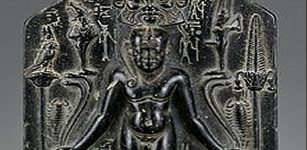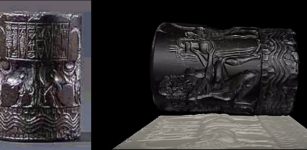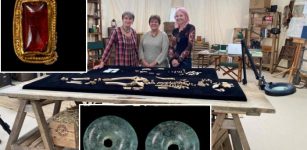Secrets Of An Unusual And Mysterious Medieval Danish Axe Revealed By Scientist
Jan Bartek - AncientPages.com - Deep in the vaults at Nationalmuseet, Denmark, is a unique axe. The Medieval axe is unusual for many reasons. It was put in a box D234/1992, and more or less forgotten. No one bothered to examine it properly until now.
Found about 30 years ago, the Medieval axe poses many questions which have not been answered until now.
What was the purpose of this peculiar axe? Credit: Gustav Hejlsesen Solberg
A new study of the 13th-century axe sheds light on the object’s purpose.
Gustav Hejlsesen Solberg, a student from the University of Copenhagen, has written a paper about the mysterious axe that was found in 1992 in the vicinity of the town of Nykøbing Sjælland.
“This axe was shown to me by Vivian Etting, as I went to look at some axes of Jan Petersens type M, during the studies connected to my master thesis on the so-called “Danish Axe,” Solberg writes in his study On the wings of an axe: Understanding a unique axe from Denmark through inter-object citation, that was appeared in Scandia: Journal of Medieval Norse Studies.
In his science paper, Solberg writes, that “the axe is thick on the backside, while the blade is relatively thin (5mm). The broad blade of the axe is 16,7 cm long and slightly tilted forward. The forward-tilted angle of the blade results in there being 9,9 cm from the back of the hammer to the bottom tip, while there is 10,8 cm from the back of the hammer to the uppermost tip of the axe.
The blade itself is also slightly warped and uneven, which made it difficult to determine whether this was a bill-like axe (from Danish Bredbil and German Beil Axt), where the edge is ground exclusively on one side.
On the back of both the horn and the beard of the axe, are located two wings with small gaps between them and the neck of the axe. The bottom one is angled further away from the neck, than the top one. The top horn of the axe also seems to be slightly larger than the bottom one, while the bottom one has a more pronounced curvature.”
The axe is unusual mainly because of its wings, and it’s hard to understand what it was used for.
“The wings on the blades are highly unusual. This is one of the most defining features of D234. This design element is not something you see all that often on axes from Denmark. It is instead highly common on central European axes and axe-like weapons from the 15th century and onwards.
Wings are also present on a number of miniature axes from Eastern Europe and the Baltics, but they are usually pointed, and not rounded as the ones on D234. They are also curved outwards and not as straight as D234’s,” Solberg writes in his study.
When the curious Medieval axe was shown to archaeologists and blacksmiths, they all said they had never seen anything like this.
Solberg’s thorough studies of the axe have led him to suggest the object was a weapon but not a very effective one. He describes the axe as a “failed experiment in the medieval weapons race.”
Solberg explains in his study that “D234 is a very strange axe. Combining elements from many different medieval axe types seems to tell us that this axe is probably from the 13th century and has been made for the purpose of warfare. Its elements are both confusing and interesting. Every part of it pulls in different directions.
Speaking more specifically about this axe, it seems like it might have tried to combine different elements from other axe types, but this might have led it to being a jack of all traits, but master of none. If this was a shot at a new axe type, then it was a miss, as this axe type didn’t catch on. D234 now stands as either a point on individualism in the 13th century, as the wielder tried to stand out, or as a failed experiment in the mediaeval weapons race.”
The study was published in Scandia: Journal of Medieval Norse Studies.
Written by Jan Bartek - AncientPages.com Staff Writer






















